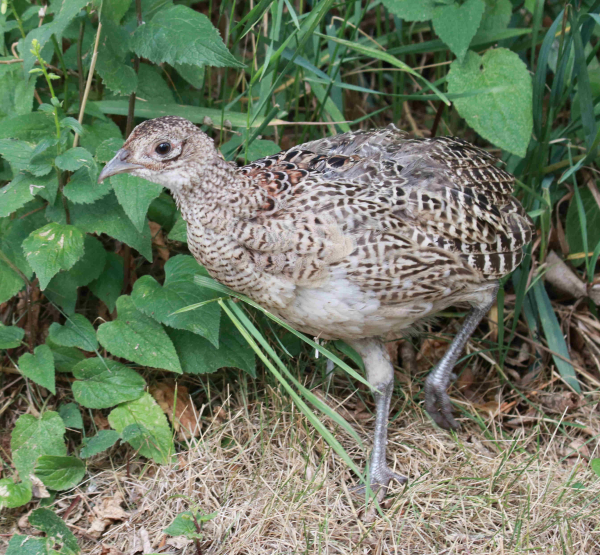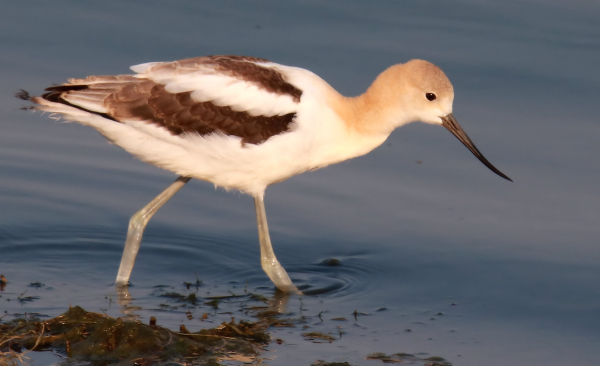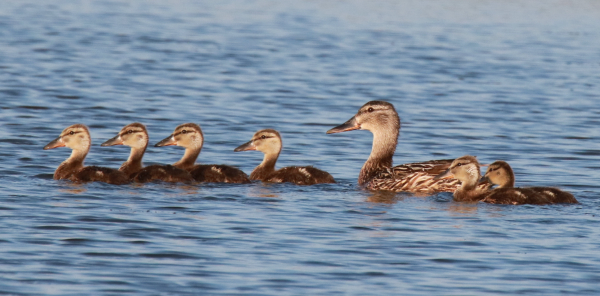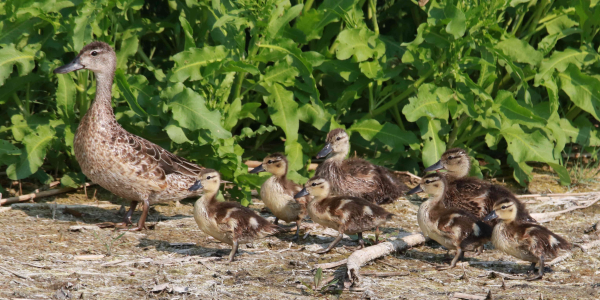
A first yard sighting of a fledgling Ring-necked Pheasant provided an opportunity to photograph the young male. The photo shows some bare red skin around its eye and some rufous-brown coloration on its upper back feathers as it molts into adult plumage.

Another update on the American Avocets that have now fledged heralds the quick maturation by week 5 at nearby Melody’s Marsh.

Mallards are one of the most common nesting ducks in this area of Dakota, providing many photo opportunities of growing ducklings.

An unusual mixed brood includes the female Blue-winged Teal’s 5 ducklings, along with 2 larger Mallard patitos. Perhaps a female Mallard laid some eggs in the teal’s nest?
|
A new species in my yard was the last thing I had in mind, but there it was, a half-grown Ring-necked Pheasant, searching for insects along the edges of tall grass I let to grow in certain areas of my yard. It worked its way into the thick cover and emerged again, foraging along the edges. I quickly grabbed my camera, but instead of trying a photo out of one of my bay windows, I stepped outside for a clearer look and photo ops. In a moment the young pheasant foraged in my direction, and I photographed as it stepped into the open. What a fun surprise!
Little did I expect the young pheasant to walk right up to me, within a couple feet, make eye contact, then move on to the next tall grass that surrounds an ash tree in my front yard, and on to the next, grabbing an insect or grass seeds here and there. Moments later, it hustled off to the west into thicker cover. I was excited, and on high alert yet 10 minutes later when I looked through an upstairs window and a movement in my backyard caught my attention – another pheasant – this one with a longer tail but still a young bird, probably a brood mate to the first young pheasant.
This fledgling worked its way through a wildflower area on the edge of my chokecherry grove, then walked along side of the ferns and lilac stand and through the sumacs to my feeding station. But without a hesitation it turned south and soon slipped out of sight too. How kool. So now I’m watching closer at ground level, watching for the next pheasant to step out of the tall green grasses and other landscaping cover.
Another Yard First
Last Sunday it finally happened – after many feeding visits for grape jelly earlier in the day, a female Baltimore Oriole brought a fledgling to my feeding station. The female initially fed the fledgling as it perched on an adjacent branch, and when the adult returned to the oriole feeder, the pale yellow-and-olive-colored fledgling with sleek new plumage flew to the top of the feeder’s shepherd's crook and took in the “secret” location of the sweetest mana food the female has been bringing to the nest.
The female returned to the tree perch, followed by the fledgling, which she fed, then flew west. However, the beautiful fledgling lingered, then repositioned as I grabbed my camera. I had a clear view of the back half of the fledgling, but ash leaves obscured the front half. I took a documentary photo and it was gone, taking a strong flight in the direction the female took. Oh well, there will be many more visits to the jelly feeder – I hope!
Indeed, the next day the fledgling oriole (or another from the female’s nest) was perched in the cover of ash leaves just above my feeding station with the female ferrying jelly to the fledgling a couple times before the adult flew to the west. The fledgling remained for a while; and in time the female returned and fed the fledgling again before both flew west. I could get used to having young orioles around, although I think it will always be a thrill to see them out my windows.
July Ducklings
Overall, during the first 2 weeks of July the dominant avian theme in south-central North Dakota has the increasing numbers of duck broods, with a high count of 10 on July first that included 6 Mallard broods, 2 Blue-winged Teal broods, a Northern Pintail brood, and near Bismarck, a brood of 1 Wood Duck duckling with its attendant hen. Closer to home, I usually found between 4 and 8 broods during evening birding drives, and Saturday evening I sighted the first Gadwall brood of the season.
Sunday, just 3 miles north of my office, I found a Blue-winged Teal hen and her brood that included 2 Mallard ducklings – twice the size of the 5 downy teal. It’s hard to say for sure how that happened: Did a female Mallard lay eggs in the teal’s nest? Or did the newly hatched Mallard ducklings adopt and imprint on the teal hen somehow after hatching? Or none of the above. Even so, it’s pretty rare to find such a mixed species brood, and a documentary photo of the mixed brood with the Blue-winged Teal female accompanies this article.
Fledging Hawks
Second to the duck broods, fledging Ferruginous Hawks were especially noteworthy. On July first, I checked the Ferrug nest located about 25 miles west-northwest of my office and sighted a sun-bleached adult hawk perched near a new fledgling in a tree 50 feet north of the nest where the other 3 young hawks remained. A week later, I checked back to find the nest was vacated, with a fledgling being harassed by a male Orchard Oriole that probably had a nest near the hawk’s perch.
A quarter mile south of the nest 2 other Ferruginous fledglings were perched on a big round hay bale in a recently cut hayfield. The bale provided an elevated perch for safety and hunting, while the low-cut grasses and alfalfa provided a preferred hunting area for ground squirrels and pocket gophers as the adults continue to feed the fledglings for some weeks after leaving the nest while they learn to fly and hunt on their own. Almost immediately, the adult female dived in overhead with a stout war cry, then circled as the male joined her from a higher elevation. I took a couple quick photos, then left to minimize any disturbance.
Back on the road, I was surprised to find another brood of recently fledged Ferruginous Hawks just 6 miles north. Also perched in a recently baled hayfield, 3 of the fledglings were standing atop a big round bale with a 4th fledgling standing on the ground in the shade of the bale. As soon as I stopped my vehicle, an adult flew low between me and the fledglings, and after taking a quick look at the young hawks and a photo, I left them undisturbed.
I didn’t see any more Ferrugs on my way to Bismarck that afternoon, but there were a few territorial Swainson’s Hawks and an abundance of Red-tailed Hawks along the way. The numbers of Red-tails included many non-nesting yearling birds, along with some hawks that were probably molting in this rodent-rich plains region after unsuccessful nesting attempts in other areas to the north. Oops, almost forgot about the other raptors – Northern Harriers, males and females that were probably on territory.
I returned with the hope of photographing the fledgling Ferruginous Hawks during sunny conditions Saturday and Sunday during prime photo time. I managed to get some memorable images, which I share with you in this issue’s Bird Photography article – please take a look at that feature and the resulting photos too.
Minnesota Aves
During a weekend trip to Minneapolis, I wanted to check on 2 nesting species – Wood Ducks and Ospreys, along with any other wildlife. My first stop in the backwaters of Lake Minnetonka yielded sightings of 3 Wood Duck broods, including photo opportunities with one of the broods. I was a bit surprised at the advanced age of the ducklings, which were probably 4 weeks old, but I initially hadn’t taken into account that I was a considerable distance south of my home latitude.
Conversely, the Osprey nestlings were surprisingly smaller than expected – small downy nestlings that could barely be seen above the rim of the nest. It was sure fun to see Ospreys so common in the area, and to monitor 3 nests built on platforms provided expressly for Ospreys. One active nest was just 2 blocks away from my niece Katy and nephew Jeff’s new home, which has a mature landscaped yard that adjoins to a large natural area. It was fun to visit them and Katy took me to the nature center where she works, which is located in the midst of a beautiful mature woodland that borders a large lake – and there is an active Osprey nest structure on site too.
Out My Bay Windows
In addition to the young Ring-necked Pheasants that foraged through my yard last week, along with the fledgling Baltimore Oriole(s), I was doubly excited by the sudden appearance of 2 male Orchard Orioles at my feeding station – 1 adult with 1 yearling that appeared to be following the former’s cues. To see these 2 Orchards together, members of the same species and the same sex, yet so different looking in tandem, it was definitely news I wanted to share with you.
The day before I had a rare appearance of a House Wren at my feeding station, although it didn’t perch at a feeder or the bird bath. House Wrens occupy the chokecherry brambles in my backyard, where I hear them sing regularly, but I can’t recall if I’ve ever had one visit the feeding station, even just to perch for a few moments.
Initially, the 4 Baltimore Orioles – 2 males and 2 females – continued to feed on the grape jelly and grab a few ants they find on the feeders, along with the Gray Catbirds. However, I haven’t seen any male Baltimore Orioles for several days, and while the younger of the 2 female Baltimore Orioles likewise is missing in action, a second dark-headed female has appeared – all pointing to the every-changing action out my windows, along with the new appearances of one or more fledgling Baltimore Orioles.
Wow, it’s mid-July already! And it’s definitely in the midst of fledging season, at least it is around here. Take note of the big picture in your neck of the woods by summing up your individual sightings, and be aware of how quickly the nesting season is progressing as you enjoy the birds around you. Happy Birding!
Article and photos by Paul Konrad
Share your bird sightings and photographs at editorstbw2@gmail.com